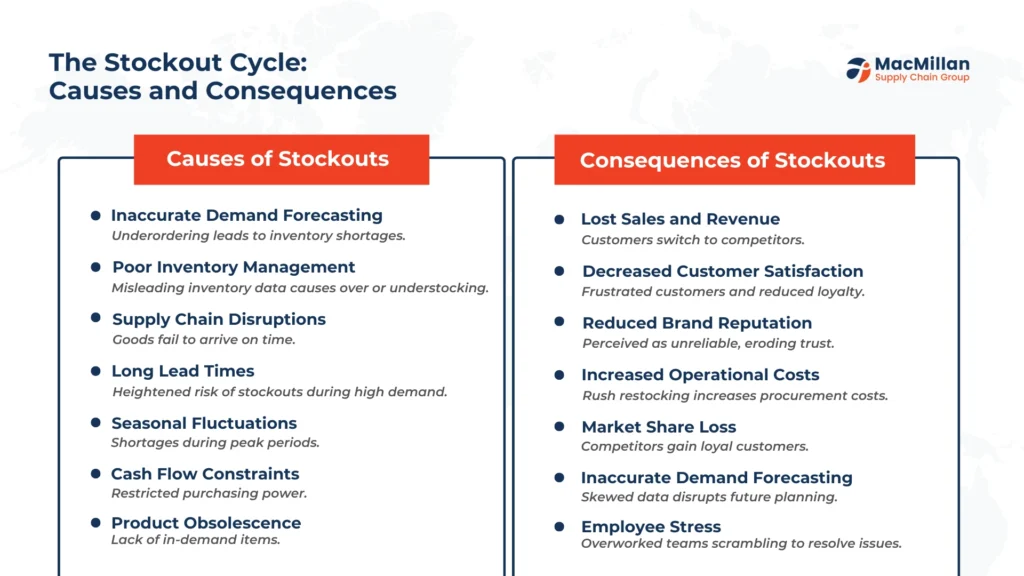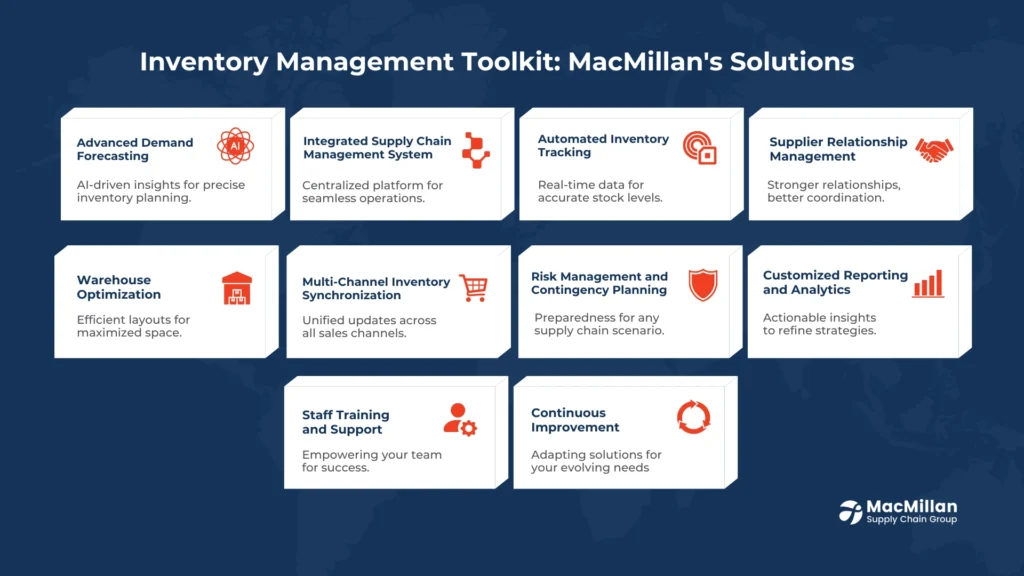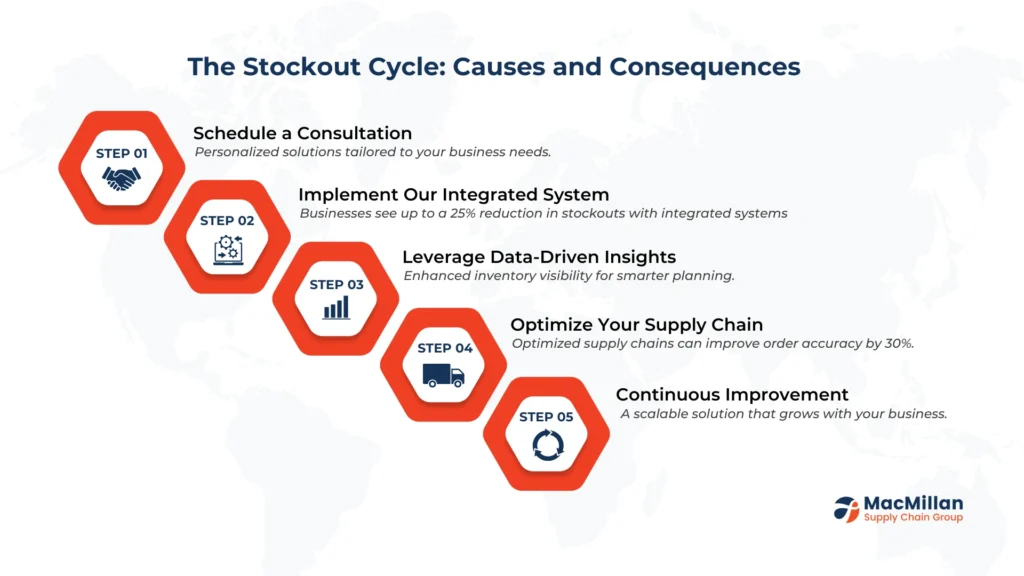A Quick Summary and Overview
Stockouts can significantly impact a business’s bottom line and customer satisfaction. This comprehensive guide delves into the causes and consequences of stockouts, offering practical strategies to prevent them. From leveraging advanced inventory management systems to implementing safety stock, we explore how businesses can optimize their supply chain operations. With insights from MacMillan Supply Chain Group, readers will learn how to enhance inventory accuracy, improve demand forecasting, and utilize buffer stock effectively. Whether you’re a small business owner or a supply chain professional, this article provides valuable information to help you maintain optimal inventory levels and avoid costly stockouts.
Introduction
In today’s fast-paced business environment, maintaining optimal inventory levels is crucial for success. Stockouts – situations where a product is out of stock and unavailable for purchase – can lead to lost sales, damaged customer relationships, and decreased brand loyalty. As businesses strive to meet ever-changing consumer demands, the challenge of preventing stockouts becomes increasingly complex.
This article aims to provide a comprehensive understanding of stockouts, their causes, and most importantly, effective strategies to prevent them. We’ll explore how advanced inventory management techniques, accurate demand forecasting, and strategic use of safety stock can help businesses maintain a delicate balance between avoiding excess inventory and ensuring product availability.
Drawing on expertise from MacMillan Supply Chain Group, we’ll delve into cutting-edge solutions and best practices that can transform your inventory management processes. Whether you’re looking to optimize your current systems or completely overhaul your approach to stockout prevention, this guide will equip you with the knowledge and tools to succeed in today’s competitive marketplace.

Understanding Stockouts and Their Causes
Stockouts occur when a business runs out of inventory for a particular product, leaving them unable to fulfill customer orders. This situation can arise from various factors, often interconnected within the supply chain ecosystem. Understanding these causes is the first step in developing effective prevention strategies.
Common causes of stockouts include:
- Inaccurate demand forecasting: Failing to predict customer demand accurately can lead to underordering and subsequent stockouts.
- Poor inventory management: Inefficient tracking systems or human error in inventory counts can result in misleading stock levels.
- Supply chain disruptions: Unexpected events such as natural disasters, transportation issues, or supplier problems can interrupt the flow of goods.
- Long lead times: Extended periods between ordering and receiving inventory can increase the risk of stockouts during peak demand periods.
- Seasonal fluctuations: Failure to account for seasonal changes in demand can lead to inventory shortages during high-demand periods.
- Cash flow constraints: Limited financial resources may restrict a business’s ability to maintain adequate inventory levels.
- Product obsolescence: Rapid changes in consumer preferences or technology can lead to stockouts of in-demand items.
By identifying these potential causes, businesses can develop targeted strategies to mitigate the risk of stockouts and improve overall inventory management.
The Consequences of Stockouts
Stockouts can have far-reaching consequences that extend beyond the immediate loss of a sale. Understanding these impacts is crucial for prioritizing stockout prevention in your overall business strategy.
- Lost Sales and Revenue: The most immediate effect of a stockout is the loss of potential sales. Customers unable to purchase their desired product may turn to competitors, resulting in both immediate and future revenue loss.
- Decreased Customer Satisfaction: Stockouts can frustrate customers, leading to a poor shopping experience and potentially damaging long-term loyalty.
- Reduced Brand Reputation: Frequent stockouts can erode trust in your brand, as customers may perceive the business as unreliable or poorly managed.
- Increased Operational Costs: Rushing to restock items can lead to higher procurement and shipping costs, eating into profit margins.
- Market Share Loss: Consistent stockouts can drive customers to competitors, potentially resulting in a permanent loss of market share.
- Inaccurate Demand Forecasting: Stockouts can skew historical sales data, making future demand forecasting more challenging.
- Employee Stress: Staff may face increased pressure and stress when dealing with disappointed customers and scrambling to manage stockouts.
By recognizing these consequences, businesses can better appreciate the importance of implementing robust stockout prevention strategies and investing in effective inventory management solutions.

Effective Inventory Management and Accuracy
Maintaining accurate inventory records is fundamental to preventing stockouts. Effective inventory management involves employing strategies and tools that provide real-time visibility into stock levels, enabling businesses to make informed decisions about replenishment and allocation.
Key strategies for improving inventory accuracy include:
- Implement Advanced Inventory Management Software: Utilize systems that offer real-time tracking, automated reordering, and integration with point-of-sale systems.
- Regular Cycle Counts: Conduct frequent physical inventory checks to reconcile actual stock levels with system records.
- ABC Analysis: Categorize inventory based on value and turnover rate to prioritize management efforts.
- RFID Technology: Employ Radio Frequency Identification for improved tracking and reduced human error in inventory counts.
- Staff Training: Ensure all employees understand the importance of inventory accuracy and are trained in proper procedures.
- Streamline Receiving Processes: Implement efficient procedures for checking and recording incoming inventory.
- Utilize Barcode Systems: Implement barcode scanning for accurate and efficient inventory tracking.
By focusing on these areas, businesses can significantly improve their inventory accuracy, reducing the risk of stockouts caused by poor record-keeping or mismanaged stock levels. Accurate inventory data forms the foundation for effective demand forecasting and inventory optimization strategies.
Utilizing Buffer Stock and Safety Stock
Buffer stock and safety stock are crucial inventory management strategies that help businesses mitigate the risk of stockouts. While similar, these concepts serve slightly different purposes in maintaining optimal inventory levels.
Buffer Stock:
– Acts as a cushion against minor fluctuations in demand or supply
– Helps maintain a consistent level of inventory
– Typically smaller than safety stock
Safety Stock:
– Protects against larger uncertainties in demand or supply chain disruptions
– Calculated based on factors like lead time, demand variability, and desired service level
– Generally larger than buffer stock
Implementing these strategies effectively involves:
- Analyzing Historical Data: Review past sales and supply chain performance to identify patterns and potential risks.
- Setting Service Level Targets: Determine the desired level of product availability to balance customer satisfaction with inventory costs.
- Calculating Optimal Levels: Use statistical models to determine appropriate safety stock levels for each product.
- Regular Review and Adjustment: Continuously monitor and adjust stock levels based on changing market conditions and business needs.
- Considering Product Characteristics: Factor in aspects like shelf life, seasonality, and product value when setting buffer and safety stock levels.
By strategically utilizing buffer and safety stock, businesses can protect themselves against unexpected demand spikes or supply chain disruptions, reducing the likelihood of stockouts while maintaining efficient inventory levels.
Common Problems with Stockouts
Despite best efforts, businesses often encounter recurring issues that lead to stockouts. These common problems highlight the complexities of inventory management and the need for robust, adaptive solutions:
- Inadequate Forecasting Models: Many businesses rely on outdated or overly simplistic forecasting methods that fail to account for market trends, seasonality, or external factors affecting demand.
- Siloed Data Systems: Lack of integration between various business systems (e.g., sales, inventory, procurement) can lead to information gaps and delayed decision-making.
- Manual Processes: Reliance on manual inventory counts and data entry increases the risk of human error and delays in updating stock levels.
- Poor Supplier Communication: Inadequate communication with suppliers about lead times, minimum order quantities, and potential disruptions can lead to unexpected stockouts.
- Inefficient Warehouse Management: Disorganized warehouses or inefficient picking processes can result in “hidden” stock that appears unavailable in the system.
- Lack of Real-Time Visibility: Without real-time inventory tracking across all sales channels and locations, businesses may make decisions based on outdated information.
- Inadequate Risk Management: Failure to plan for supply chain disruptions or sudden demand spikes can leave businesses vulnerable to stockouts.
Our Solutions
At MacMillan Supply Chain Group, we offer comprehensive solutions designed to address these common stockout problems and optimize inventory management:
- Advanced Demand Forecasting: Our AI-powered forecasting models incorporate multiple data points, including historical sales, market trends, and external factors, to provide highly accurate demand predictions. This allows businesses to anticipate future needs and adjust inventory levels proactively.
- Integrated Supply Chain Management System: We provide a centralized platform that integrates all aspects of the supply chain, from procurement to sales. This ensures seamless data flow and real-time visibility across the entire operation, enabling more informed decision-making.
- Automated Inventory Tracking: Our solutions include state-of-the-art inventory tracking systems, utilizing technologies like RFID and IoT sensors to provide real-time, accurate stock level information. This minimizes human error and ensures up-to-date inventory data.
- Supplier Relationship Management: We help businesses establish and maintain strong supplier relationships through our supplier portal and communication tools. This facilitates better coordination, clearer lead time visibility, and proactive management of potential supply issues.
- Warehouse Optimization: Our warehouse management solutions include layout optimization, efficient picking strategies, and inventory organization tools to maximize space utilization and minimize the risk of misplaced or overlooked stock.
- Multi-Channel Inventory Synchronization: Our systems provide real-time inventory updates across all sales channels, ensuring consistent stock information whether customers are shopping in-store, online, or through marketplaces.
- Risk Management and Contingency Planning: We work with businesses to develop comprehensive risk management strategies, including identifying alternative suppliers, optimizing safety stock levels, and creating contingency plans for various scenarios.
- Customized Reporting and Analytics: Our solutions offer in-depth reporting and analytics capabilities, providing businesses with actionable insights to continually refine their inventory management strategies.
- Staff Training and Support: We provide comprehensive training programs and ongoing support to ensure your team can effectively utilize our systems and implement best practices in inventory management.
- Continuous Improvement: Our solutions are designed to evolve with your business needs. We regularly update our systems based on the latest industry trends and technologies to ensure you always have access to cutting-edge inventory management tools.
By partnering with MacMillan Supply Chain Group, businesses can leverage our expertise and advanced solutions to transform their approach to inventory management, significantly reducing the risk of stockouts while optimizing overall supply chain efficiency.

How Readers Can Avoid Stockouts with MacMillan Supply Chain Solutions
Implementing effective stockout prevention strategies doesn’t have to be a daunting task. With MacMillan Supply Chain Group, you can transform your inventory management processes and minimize the risk of stockouts. Here’s how you can get started:
- Schedule a Consultation: Contact our team for a comprehensive assessment of your current inventory management processes. We’ll identify areas for improvement and tailor our solutions to your specific needs.
- Implement Our Integrated System: Our team will work closely with you to implement our advanced inventory management system, ensuring seamless integration with your existing operations.
- Leverage Data-Driven Insights: Utilize our advanced analytics tools to gain deeper insights into your inventory performance and make data-driven decisions.
- Optimize Your Supply Chain: Work with our experts to streamline your entire supply chain, from supplier relationships to warehouse management.
- Continuous Improvement: Benefit from our ongoing support and regular system updates to stay ahead of market trends and continuously refine your inventory management strategies.
Don’t let stockouts harm your business any longer. Take the first step towards optimized inventory management by partnering with MacMillan Supply Chain Group. Contact us today to learn how our solutions can help you prevent stockouts, improve customer satisfaction, and boost your bottom line. Let’s work together to build a more resilient and efficient supply chain for your business.
FAQs
A stockout occurs when a business runs out of inventory for a specific product, making it unavailable for purchase. This situation can lead to lost sales and customer dissatisfaction.
Accurate demand forecasting involves analyzing historical sales data, market trends, and external factors. MacMillan Supply Chain Group offers advanced AI-powered forecasting tools that consider multiple data points to provide highly accurate predictions.
Safety stock is extra inventory kept to protect against uncertainties in demand or supply. The calculation typically involves factors like lead time, demand variability, and desired service level. Our experts can help you determine optimal safety stock levels for your specific business needs.
Real-time tracking provides up-to-date information on stock levels across all locations and sales channels. This allows for quicker response to low stock situations and more accurate replenishment decisions. MacMillan's solutions offer advanced real-time tracking capabilities.
Effective supplier management ensures timely deliveries and clear communication about lead times and potential disruptions. Our supplier relationship management tools help businesses maintain strong connections with suppliers and anticipate potential issues.
Improving warehouse inventory accuracy involves regular cycle counts, implementing barcode or RFID systems, and optimizing warehouse layout. MacMillan offers comprehensive warehouse management solutions to enhance accuracy and efficiency.
Costs can vary based on the size of your business and the complexity of your needs. However, the long-term benefits of preventing stockouts and optimizing inventory levels often far outweigh the initial investment. Contact us for a personalized quote.
Implementation timelines can vary, but we strive to have basic systems operational within a few weeks. Full integration and optimization may take a few months, depending on the complexity of your operations.
Yes, our solutions are designed to integrate seamlessly with a wide range of existing systems. We'll work closely with your team to ensure smooth integration and data flow across all platforms.
We prioritize data security and employ industry-leading encryption and security protocols. Our systems undergo regular security audits and updates to protect your sensitive business information.
